
Mess Etiquette and Mess Dinners
(Adapted from an Infantry School Handout issued in the 1980s.)
General
1. Mess dinners provide an opportunity for mess members to meet on a formal but friendly occasion, allowing the CO or his guests to address the members as a group. By custom and tradition mess dinners are considered to be a parade and as such, attendance is compulsory except for members excused by the CO.
2. The following provides a guide to the general procedures for mess dinners. Tradition may produce variation in individual messes. All ranks must acquaint themselves with the special customs or variations in messes to which they belong or visit. Units or messes have a responsibility to brief visitors or guests on mess customs, especially if they vary from usual procedures.
RSVPs
3. RSVP.
"Répondez s'il vous plaît", a French phrase that translates to "please respond" and word for word translation is "respond if you please"
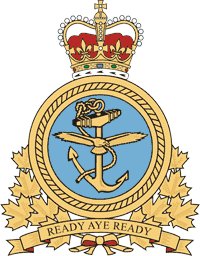
For a Naval point of view, see the Mess Dinners section of this edition of advice for Naval Officers by Captain (N) (Retired) Robert "Bob" G. Allen:
What You Always Wanted to Know about Naval Tradition (But were afraid to ask) (pdf)
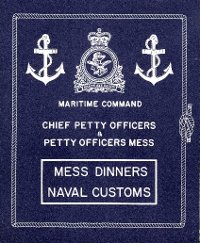
This MARCOM CPOs' & POs' Mess; Mess Dinners and Naval Customs booklet (PDF) also offers guidance on Messes and Mess Dinners in the Canadian Forces.
4. There are few things more aggravating for a Mess Dinner organizer than wondering who's coming to dinner, and how many times arrangements will have to change due to late RSVPs. It's really quite simple: when you receive the invitation, answer the RSVP in a timely manner. Now, in recent experience, the two worst groups for responding to RSVP are:
a. those officers in a unit who presume their attendance at a "parade" is assumed, and
b. those VIPs and persons of import who believe they can respond in their own good time.
5. No doubt, some of the first group are reading this in advance of an upcoming dinner and will now RSVP soon if they haven't already done so. The second group is less likely to be reading this page, maybe because they may think they've nothing to learn here, so the following remarks directed at them are effectively to those of the first group who may one day be in the second. VIPs can affect the seating plan and also arrangements for programmed events at the dinner. They may be asked to speak, and then possibly "un-asked" when some higher priority guest decides at the last minute to announce their availbility. Slow responses to RSVPs cause extra work and stress which are completely unnecessary. The attendance of any guest at a Mess Dinner should not cause the organizer an extra burden of work above what should be expected if they attend. To do so by responding late to an RSVP is, quite simply, rude and inappropriate. And for those who might claim scheduling uncertainty at high altitudes of the chain of command, a tentative "yes" is always much better than a last minute "no."
Guests
6. Frequently, guests may be invited to mess dinners. Guests will be in one of two categories as follows:
a. Mess Guests - a mess guest is a person whom the mess, as an entity, has a social or public obligation to entertain and for whom the mess is financially responsible; and
b. Personal Guests - a person whom a member of a mess invites to the mess and for whom the member is responsible. Guests at the dinner are the guests of all the mess members and it is the responsibility of all those present to see that the guests are entertained and not left to fend for themselves. Personal guests will not be invited to a mess dinner without the approval of the CO.
Announcements
7. The announcement of a mess dinner can be made by verbally via the chain-of-command, by memorandum, in routine orders, on the mess notice board, or in a social calendar. Attendance is normally considered compulsory unless excused by the CO, or the PMC.
8. The PMC (short for President of the Mess Committee) will be responsible for the arrangements for the Dinner and conduct the dinner from his place at the right hand end of the head table. The CO will appoint the PMC for the dinner (hence this individual is not necessarily the PMC for the Mess itself). The junior subaltern will be the Vice-PMC. A mess steward will also normally be designated for the dinner to coordinate the actions of catering staff and to assist the PMC in controlling the pace of the dinner or other small tasks as assigned. The mess steward (sometimes referred to as the Mess Sergeant) will normally be a volunteer MCpl or Sgt of the Regiment, who may be paid an honorarium from the dinner funds. Within Reserve units, it is improper for an NCO to be permitted to “sign in” and accept DND wages for this task, as it is considered offsetting the costs of a non-public event with public money.
Dress
9. The dress for mess dinners will be posted on the mess notice board or as indicated by invitation, letter or promulgated in routine orders. Generally, the dress will be mess dress or equivalent. For officers not yet in possession of mess dress, service dress will be the norm, some regiments expect their officers to wear service dress with white shirt and black bow tie for such occasions. Civilian members or guests will wear evening dress (“black tie”/tuxedo) or dinner jacket with the CO’s approval.
Assembly
10. The time of a function will always be given (e.g. “1900 for 1930 hrs” or “1930 for 2000 hrs”). You are required to be there by that time. There is no such thing as being sociably late. The expression 1900 hrs for 1930 hrs is not designed to give you flexibility. You are required to be there at 1900 hrs. This pre-dinner gathering is to enable members to meet and entertain guests, have a pre-dinner drink, and ascertain their position at the table from the seating plan that will be placed in the lounge or at the entrance to the dining room where every member can see it.
11. The mess steward will inform the PMC when dinner is ready. If the CO and guests appear to be ready, the PMC shall inform the CO and, having received permission, pass word to the bugler or piper (if in attendance) to play "Mess Call." Mess calls will normally be given 15 minutes and five minutes before entering the dining room. This allows members time to finish drinks and/or visit the facilities before dinner. The CO and PMC (or other officers designated to do so) will lead the assembly into the dining room, escorting the senior guests to the head table. The senior guest of honour will sit at the right hand side of the CO, with the next senior guest of honour to the seat on his left-hand side. The remainder will proceed directly to the dining room to their places as designated in the seating plan.
Seating Plan
Place cards have another role. They are often used to pass a note down the table, ostensibly to the PMC, though any note passed along the table may be read, minuted (i.e., added to), or shanghaied by the intervening officers.
12. All members except honoured guests should look over the seating plan, usually posted near the dining room, and make sure they know where they are seated well before the move to the dining room is made. You should pay particular attention to the person who is seated to your right. As a general rule you should entertain the guest on your right prior to going into dinner and see that he finds his seat. Similarly you should entertain this person during the dinner. At a “Dining In,” where the officers and their ladies are present, each officer should escort the lady to his right to her chair and assist her in taking her seat.
13. Members and guests shall stand behind their chairs. The mess steward reports, sotto voce, to the PMC that "all members and guests are present, Sir". At this time, the PMC raps the gavel once for silence, and will request that the Padre, the VPMC or another person say Grace. Some regiments have a Regimental Grace, which is given at this time; others may leave it to the Padre or other officer to choose their words. Being asked to say Grace should not be a surprise, and a junior officer requested to do so should confirm the appropriateness of their intended Grace with the PMC before the dinner.
Place Cards
14. Before each place setting at the Mess table will be a small card displaying the officer's name. This is provided as an aide to finding one's seat. Some place cards are very simple, of white card stock with typewritten names. others may be more ornate with the Regiment's cap badge emblazoned on them, or for special dinners the badges of the individual officers (a trick which requires a little more work on the part of the officer tasked to organize the dinner).
15. Place cards have another role. They are often used to pass a note down the table, ostensibly to the PMC, though any note passed along the table may be read, minuted, or shanghaied by the intervening officers. (Notes of import which must reach the PMC are best sent via the Mess Steward.) In any case, the presumption made on receiving any such note is that it originated with the officer whose place card it originally was. It is for this reason that new officers may see others at the dinner immediately pocket their own place cards, a cautionary act often carried out by those who have a history of employing others' cards to send less than complimentary messages.
Regimental Silver and Trophies
16. Many Regiments will decorate the mess table with memorabilia or trophies. Some will designate particular officers' locations, for example: the statue of Mercury for the Battalion Signals Officer used by the Second Battalion, The Royal Canadian Regiment (2RCR). Others may identify the recipient of an award; such as 2RCR's placement of the Mons Box (awarded to the best platoon commander each year) at the last recipient's seat throughout the following year. Other items may be placed on the mess table in recognition of the Regiment's history; the Princess Louise Fusiliers in Halifax always place a Vickers machine gun at the centre of the head table, commemorating the Regiment's role in the Second World War. While care should be taken not to crowd the table such that normal discourse is inconvenienced, mess dinners are an excellent opportunity for the Regiment to display treasured articles seldom available for close examination. Newly joined officers should be encouraged to view and learn the importance of such trophies, for they form an part of their regiment's history and culture. Also, care should always be taken to ensure no harm comes to these items during mess games, many of which are irreplaceable; as much for their material value as for their sentimental value.
Behaviour at the Mess Table
17. Because the dinner is a formal function, special rules will be observed. These include that no diner may:
a. smoke during the meal, even if held in a facility which allows smoking;
b. commence a meal before the PMC, who will likely pause until the head table has been served;
c. discuss political or other controversial subjects;
d. act in a boisterous manner;
e. propose a toast;
f. talk after the PMC summons attention until he has finished speaking; and
g. leave the table during the meal unless permitted to do so by the PMC.
18. Keep in mind that varying levels of decorum may be observed within regiments depending on the location of the dinner, the presence of guests, the purpose of the dinner, and a myriad of other reasons. Erring on the side of caution is always best, despite being regaled with tales of past dinners at the mess bar in preceding months. Learning to read the situation and the CO’s mood in this regard is as valuable a social grace as any a young officer might acquire as a subaltern (not to mention learning who’s example to follow in order to minimize the effects of post-dinner fallout).
19. At the conclusion of the meal, all china, silverware, placemats, flowers, and glasses, with the exception of the port glass, will be removed from the table. If you failed to finish something because the discourse over dinner was so engaging, surrender it to the wait staff with grace.
Passing the Port
20. When the table is cleared, the port decanters are placed on the table in front of the PMC. If a large number of diners are in attendance, decanters will also be placed in front of the VPMC and at the end of each wing table on the left-hand side. When they are in place, the PMC and VPMC unstopper the decanters, charge their glasses, and then pass the decanters to the left. Other members having had decanters placed in front of them, will also fill their glasses and pass the decanters to their left. Whether the decanter touches the table or not is a matter of mess custom, there is no standing Army custom one way or another. Some Regiments have affected local custom in this regard, in some cases, such as banging the decanter on the table before passing it, these customs are best practiced only in their own messes where the responsibility for the tables and decanters lies with that regiment’s officers. No one should touch their port until the Loyal Toast (i.e., the toast to Her Majesty, The Queen) has been proposed. If someone does not drink alcohol due to medical or other reasons, they may drink the Loyal Toast with water.
The Loyal Toast
21. When all glasses are charged, the PMC raps his gavel for silence, then stands and, addressing the VPMC, says, "Mr. Vice, The Queen of Canada." The VPMC then stands and, addressing all present in the other official language, says "La Reine du Canada" (i.e., “Gentlemen, The Queen of Canada”). Conversely, the PMC may ask for the loyal toast in French, requiring the VPMC to respond in English. All then stand and, if a band is in attendance, one verse of God Save The Queen is played. During the playing of God Save The Queen, the port glasses may be left on the table or held in the right hand at waist level while standing to attention; the custom may vary between elements and units. When the band has stopped playing, all members respond with "The Queen," or "La Reine" and drink. All present then sit down and conversation is resumed.
22. The Loyal Toast may be followed by others, such as:
a. To the heads of state of foreign guests, and
b. To the regiment’s Colonel-in-Chief.
Other Toasts
23. Fallen Comrades. It has become customary in some Messes to toast fallen comrades. This may take the form of a simple toast "To Fallen Comrades" requested by the PMC of one of the members present. Alternatively, some Messes set a separate table place setting in honour of the fallen, and when desired, an explanatory description of the place setting and a longer version of a Toast may be presented.
24. The Ladies. Traditionally, in Dinings-In, the ladies (harkening back to a time when all serving officers were male) would also be toasted for their perseverance in support of their soldier-husbands. This custom is still followed, although it may well be a male guest standing with the male officers and toasting his serving partner in the execution of this toast.
25. The Regiment. Mess Dinners held by a unit in which all present are members of 'the Regiment' by cap badge or by association through service, may include a toast to the Regiment. Often, a senior member of the Regiment is requested to make this toast, and has the freedom to deliver it as he (or she) sees fit, marking the connection between the Regiment of the current day with its past.
Following the Toast(s)
26. Following the toast(s), coffee will be served, and in the increasingly rare instance that the dining location permits smoking, the PMC gives permission to smoke by lighting a cigarette or by passing a cigarette to a neighbour. Waiters will place ashtrays on the table, followed by the serving of liqueurs. (Note: In Canadian Forces no smoking is allowed. Officers should be sure of any restrictions at dinners in other locations before attempting to light up.)
27. If a band is in attendance, regimental marches may be played as directed by the PMC. In lieu of a band, recorded music may be used.
a. Officers will stand for their own regimental or corps marchpast. In some messes, officers of the hosting unit do not stand for their own marchpast, which may be played last (regardless of its place in the order of precedence).
b. Regimental marches will be played for each of the regiments or corps with officers attending the dinner. Only the regiments in which they currently serve will have the marches played, though an officer may also stand for the marches of any unit in which he/she has served previously. Marches will be played in order of precedence. (See A-AD-200-000/AG-000, The Honours, Flags and Heritage Structure of the Canadian Forces for orders of precedence.)
c. If a given marchpast represents more than one regiment with officers present at the dinner, the marchpast is played in the order of march for that unit which is first in the order of precedence, and all officers from units with the marchpast will stand for it at that time. (For example: Regiments/corps with the marchpast “British Grenadiers” are: The Artillery Branch (quick march for dismounted parades), The Canadian Grenadier Guards, The Royal Regiment of Canada and the Princess Louise Fusiliers. The Royal Regiment of Canada follows “British Grenadiers” with “Here's to the Maiden” and, as such, would be considered to constitute a separate marchpast at Mess Dinners. When officers may be sharing a marchpast at a mess dinners, the officers of both regiments in attendance should confirm that their marchpast will be played alone and separately and in the order of precedence for the senior regiment.
28. During coffee, the CO will ask the mess steward to bring the band director and/or piper to him. He will introduce him to the senior guest and the mess manager will bring a chair (or chairs as needed) to be placed behind and between them for the band director and piper. The CO will invite the band director or piper to have a drink. The Mess Manager personally brings the drinks on a tray. After his drink, the band director or piper asks permission to retire, and the extra chair is removed. The CO may ask the mess steward to bring forward the chief cook; the same procedure applies as for the band director or piper. As the cook is concluding his visit with the CO, the Mess Steward will normally bring the remainder of the kitchen or catering staff into the dining room, the assembly will express their gratitude for the kitchen and serving staff’s efforts with a round of applause.
Speeches
29. Should there be any speeches, they follow at this point. In some messes, speeches or presentations may be done before the dinner, specifically to keep them brief as well as to avoid prolonging time spent at the table following the meal. The PMC will get everyone's attention by rapping the gavel three times and will call upon the CO to speak if he desires to do so. Indication that a dinner is officially over will normally be given by the PMC standing up until noticed by all members. If the CO and the guests of honour leave immediately, it is customary for the members to stand until they have left the room. The PMC accompanies the guests to the lounge.
After Dinner Entertainment
30. Following the dinner, the members should retire to the lounge. A program of entertainment or games may follow the dinners depending on regimental custom. This is the most relaxed part of the evening, affording an opportunity for all members to become better acquainted. Members should not leave the mess until after the CO and guests have departed. If a member has reason to leave before the CO, he should first pay his respects to the CO, but there must be sufficient members remaining to ensure the entertainment of guests so long as any remain in the mess. Paying your respects merely means saying “Good Night” to the CO. You should pay a similar compliment to the PMC and your OC.
Tradition
31. It is reiterated that tradition may produce minor variations in procedure for mess dinners, but the overall purpose and the formality of a mess dinner will always remain.
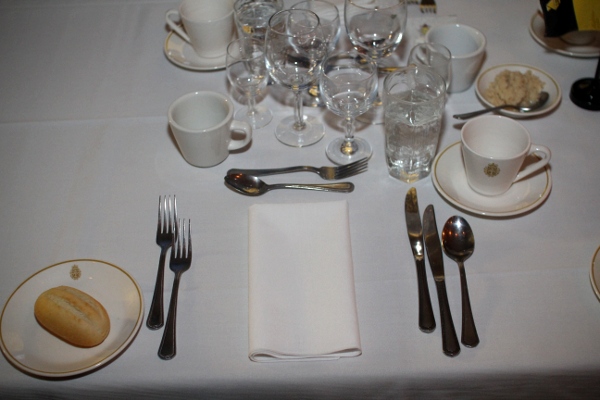
A typical table setting for a four-course meal (soup, salad, entree, dessert). The glasses, in order from right to left are for ice water, white wine, red wine and port. To the front left of the port glass is a white china mug for the drinking of a regimental toast (used by The Royal Canadian Regiment).
Table Manners for Formal and Informal Dinners
32. If you look at eating as a maintenance function then you may feel that the mechanics of the function itself is a secondary nature. If your sole idea of cuisine is paper-wrapped and from a drive-through window, perhaps you should immediately resign your commission and take find a career with less strenuous social expectations. Good food is rendered that much better when one has good silver, tableware, crystal, fine wine and enjoyable company. An oaf who eats with his mouth open, knows little, and cares less about how to handle the instruments before him can ruin this atmosphere. He is not only an embarrassment to his fellow officers; he puts you off your food.
33. A Mess Dinner is not supposed to take on the appearance of a Meeting Engagement or a knife fight. The food on your plate is already dead; you are not required to kill it. Nor is the consumption of each course a race. The only prize you are likely to get for finishing first is gas.
34. Still, the matter of eating in public is more important to an officer than many realize. You can very easily embarrass not only yourself but also your fellow officers and particularly the CO. Though perhaps difficult to describe, it is, nevertheless, simple to follow:
a. Posture. One should always sit in an erect position; never loll or lounge or prop elbows on the table. When not occupied with knife and fork, the hands should rest in the lap. Elbows are kept close to the side at all times. The body should be approximately six inches from the table;
b. Drawing designs on the tablecloth with knife and fork, crumbling of bread, beating a tattoo on the table with the silverware, playing with the wine glasses, etc., are all in bad taste. Gentle manners and quietness in eating mark a well-bred person;
c. Napkin. The table napkin is partly unfolded, not in view of those present but on the lap, and laid flat across the knees. Never tuck it in front of your tunic. After the meal the napkin is not folded, but laid carelessly on the table;
d. Silverware. The silverware is laid out in the order in which it is to be used, working from the outside in. The knives to the right of the plate, the forks to the left with the dessert utensils and sometimes the soup spoon placed at the top.
e. How to Use the Utensils. While less formality is expected than with your Commanding Officer's or the Distinguished Guests' generations, awareness of proper dining etiquette can help avoid embarrassment not only at mess dinners but also in front of potential future mother-in-laws:
(1) Soup is always taken from the side of the spoon. The motion of the spoon is from front to back of the plate. Never tip the plate to get the last drop, or blow on the soup to cool it;
(2) If consommé or bouillon is served in a double handled cup, a teaspoon or bouillon spoon is used first. After part of the bouillon is consumed it is traditionally permissible to lift the cup to the lips with the right hand;
(3) A knife is held in the right hand, cutting edge down, with the index finger extended along the back of the blade. (Never cut rolls with a knife; break rolls with the fingers);
(4) The fork is held in the left hand, prongs down, to eat the food that the knife cuts. Vegetables may be eaten by holding the fork in the right hand, prongs up, or in the left hand, prongs down. In the latter case, the knife is used to help place food on the fork;
(5) To indicate whether you have finished with a course, place the utensils as shown in the accompanying diagram:
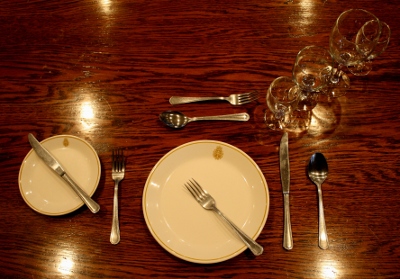
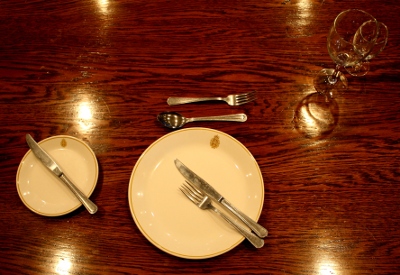
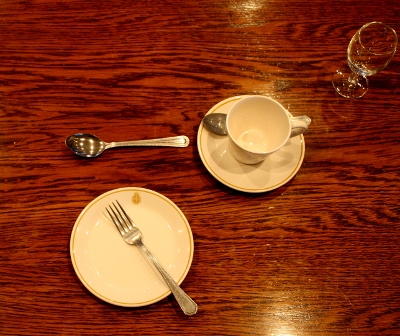
Placing the utensils to indicate you have finished the course and the staff may remove your plate.
f. Do not ask for seconds;
g. It is not polite to ‘trade’ food at a mess dinner; and
h. If something is placed in front of you that you do not like, do not refuse it. Leave it there. If you do not like it, do not eat it. It is not necessary to mash it up, nobody really cares whether you eat it or not.
Conversation
35. The well-bred person is careful not to speak with food in his mouth, or gesticulate with utensils in his hand. The conversation should be tactful, kind, responsive, brief, and cheerful. Unpleasant topics should be avoided; to imitate anyone is ill mannered. Controversial topics such as religion, politics or the opposite sex should, by common consent, be avoided.
36. Do not ignore guests after dinner. Also, do not take it as your personal crusade to monopolize the conversation with the nearest General Officer in order to tell him the shortcomings of his Command or to “sort him out”. There is nothing worse than witnessing a Second Lieutenant with a few months in rank telling a General what it is really all about. It is disrespectful, rude, unprofessional, and the height of ignorance.
Additional Points
37. A well-bred guest never asks for anything that is not offered, such as butter, vinegar, catsup, as this is a reflection on the dinner. Food should not at any time be piled on the fork. Lumps of sugar should not be taken from the bowl with the fingers. If tongs are not provided, a clean spoon should be used.
38. Tea or coffee cups should not be suspended in the air, but raised to the lips, short sips being taken and the cup replaced on the saucer. A teaspoon is not used to taste the tea or coffee but to stir it only. To crook the little finger when lifting a cup looks affected, and affectation of any kind denotes bad manners.
39. Traditionally, officers were expected to remain at the table throughout the meal, regardless of duration and the possible effects of consuming wines with each course. More experienced officers may recall dinners last four hours or more with copious quantities of wine. Despite the inevitable cautions to remain in place by those who delight in seeing others in discomfort or embarrassing situations, officers who must leave the table for urgent reasons should do so. If time permits, a note passed to the PMC via the Mess Sergeant requesting permission to leave the table should be proffered. In any case, the immature taunts of others for summarily leaving the table remains preferable to the potentially more embarrassing results of ‘toughing it out.’
After Dinner Activities
Finishing the Port
40. There is a long standing tradition in which the subalterns will remain at the mess table in order to finish the port. While there doesn't seem to be a definitive explanation for this, the one most offered that makes some degree of sense is that it offered the subalterns an opportunity to imbibe the remaining port at the shared expense of the entire mess, giving some relief to their own pockets to the enjoyment of the evening. Sadly, many Regiments are stingy in the selection of their port, and it is widely considered to be a poor wine to finish the evening with, but one which has unfortunately come to be accepted as part of the mess dinner tradition. With care in selection (and a few dollars more), very decent port can be provided to the dinner and allow the subbies the opportunity to enjoy the remainder as gentlemen (and ladies) rather than as a standing challenge to consume poor vintage simply because the preceding generation of officers were subjected to it.
Subbie's Court
41. In some regiments, post mess dinner activities may include a Subbie's Court. Hearkening back to a time when the subalterns merrily welcomed any opportunity to enjoy libations at the expense of their more affluent superiors, Subbie's Court is a mock Court Martial, normally headed by the Senior Subaltern with accompanying designated fellow judges and other court appointments held by selected subalterns. Intended to be held in good humour and without vindictiveness, the Subbie's Court is a mechanism by which subalterns may bring "charges" against senior officers, hear the evidence against them, and pronounce sentence upon determination of guilt. Traditionally, fines awarded by the court would be paid in drink provided to the Regiment's subalterns. Charges at Subbie's Court could range the 'flagrant abuse of red ink on subaltern's officers' work" brought against an Adjutant intent on developing the sufferers' staff duties to the "irresponsible scheduling of training activities that intrude on the start of happy hours" charged against an energetic Company Commander.
See The Subalterns' Court for a more complete description.
- The O'Leary Collection; Medals of The Royal Canadian Regiment.
- Researching Canadian Soldiers of the First World War
- Researching The Royal Canadian Regiment
- The RCR in the First World War
- Badges of The RCR
- The Senior Subaltern
- The Minute Book
- Rogue Papers
- Tactical Primers
- The Regimental Library
- Battle Honours
- Perpetuation of the CEF
- A Miscellany
- Quotes
- The Frontenac Times
- Site Map
QUICK LINKS
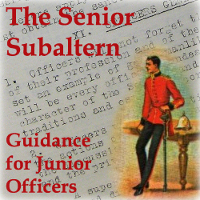
- The Senior Subaltern
- Staff Duties and the Young Officer
- How to Write Effective English
- Notes and Quotes - Staff Duties
- Advice to Officers (1782)
- Mess Rules of the Infantry School (1884)
- A Dozen Military Epigrams (1901)
- How The Loafer's Bred (1904)
- The Promotion and Examination of Army Officers (1904)
- A Few Tips for Officers, Before and After Joining (1906)
- Standing Orders of The RCR (1910)
- Standing Rules for Officers' Messes of The RCR (1913)
- The Young Officer's Guide to Knowledge (1915)
- The Duties of an Officer (1916)
- An Open Letter to the Very Young Officer (1917)
- Advice to a Young Officer (1917)
- Battalion Duties; Officers, NCOs, and Soldiers (1917)
- Pleasing Infantry Brigadiers (1917)
- Role and the Responsibilities of the CO in a Battalion Mess (1917)
- The RCR, "A" Company Standing Orders (1918)
- Some Staff Duties (1923)
- An Officer's Code (1925)
- Hints on Promotion Exams (1925)
- On Writing Appreciations (1926)
- The RCR; Rules for Officers' Messes (1927)
- Morale And Leadership (1929)
- RCSI Hints for Young Officers (1931)
- RCSI Notes on Drill (1931)
- The Study of War by Junior Officers (1932)
- Self-Training (1934)
- "The Problem of the First Ten Years" (1934)
- Standing Orders of The RCR; 1935)
- Customs of the Service (1939)
- Drill and Discipline (1939)
- Leaders Win Where Commanders Lose (1939)
- The Officer and Fighting Efficiency (1940)
- Officers' Mess (RCAF, 1940)
- The Duties of an Officer (1942)
- Comrades in Arms (1942)
- Example Standing Orders - Subalterns (1942)
- Hints for Newly Commissioned Officers (1943)
- Completed Staff Work (1943)
- FOLLOW-ship (1943)
- Hints for Junior Officers (1945)
- Officer-Like Qualities (1948)
- Military Writing (1948)
- An Analysis of the Sub-Unit Commander (1949)
- Leadership (1950)
- Neptune's Notes (undated, 1950s-60s)
- Thinking and Writing (1953)
- Examination Tactics (1953)
- Officers (1954)
- On Writing Examinations (1954)
- Customs of the Army (1956)
- 1st Bn, The RCR, Senior Subaltern (1956)
- Pigs Have Wings (1960)
- Leadership and Man Management (1960)
- Officers (1964)
- 1RCR - The Sergeants' Mess - "Tips" (1971)
- 2RCR Junior Officer's Handbook (1973)
- How to be a Successful Subaltern (1978)
- Foreword to the Infantry Journal, No. 8 (1979)
- Do You Appreciate the Finer Points of Life? (1980)
- The RCR Regimental Standing Orders - Senior Subaltern (1992)
- Infantry Company Command (2016)
- A Miscellany of Advice for Subalterns
- The Young Officer and the NCO - Quotes
[an error occurred while processing this directive]